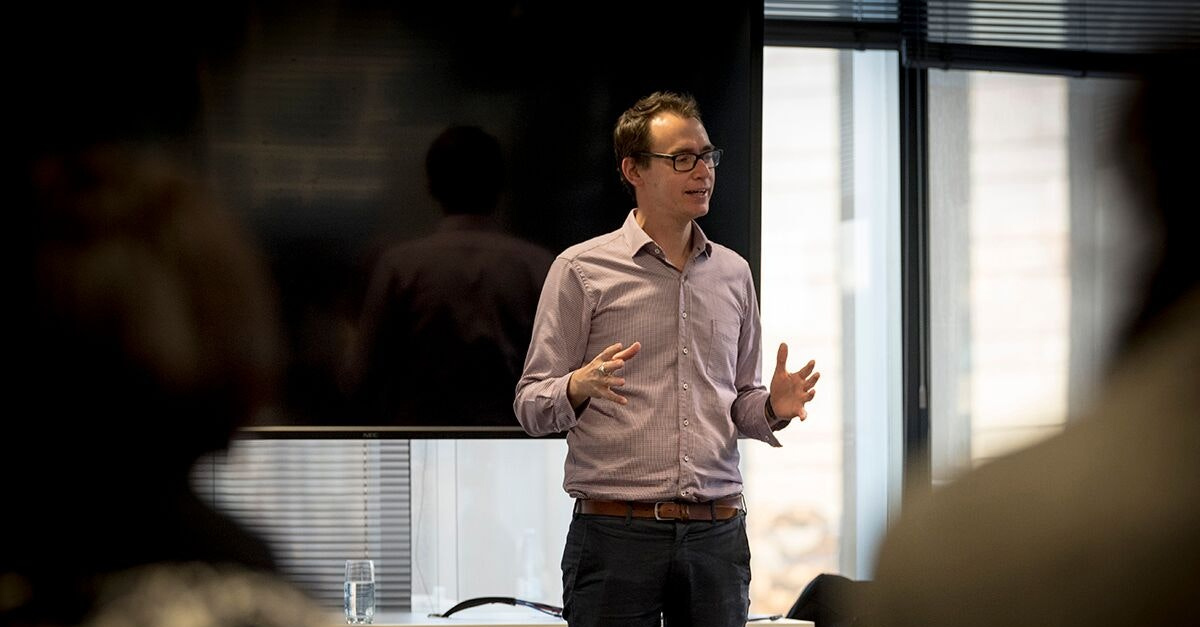I had a life-changing experience around 18 months ago, sitting in the auditorium at Swinburne Uni as LAST (Lean, Agile and Systems Thinking) Conference got underway. I was presenting later that day, so my energy was a familiar mix of anticipation, excitement and nerves—I usually find it hard to relax and take much else in until my presentation is done.
I had attended a few LAST Conferences in previous years, and the opening session is usually quite informal and lightweight. So I settled into my chair expecting more of the same.
And then came the surprise.
After a minute of watching some people fuss around with the computer at the front of the room, up on the huge screen in front of us was Peter Senge sitting at his desk in Boston—casually talking into his webcam, live and in real time. He proceeded to deliver an hour-long keynote with such incredible elegance and ease. It didn’t feel overly prepared or rehearsed, but he also didn’t miss a beat. It blew my mind what we can achieve with technology in this day and age—that one of the world’s most significant thought leaders can be sitting in an office communicating so directly and intensely with 400 people on the other side of the world.
Peter’s keynote covered many themes about business and society, and the role of systems. However it was a particular anecdote that he shared which was the lightning rod for me. He talked about his work with business leaders such as global CEOs, and that the common pattern he encounters is that people are just too busy to ever slow down and to actually think—some people say it feels like years since they actually had the chance to do so. He went on to explain that it is only through reflection that we can change our history, and that we need to create the culture and atmosphere that allows us to think together, and to see the broader system.
Take a moment, and reflect on this:
When was the last time you and your team actually had the time and space to go deep and think together, without the meeting timer counting down and your busy agenda weighing on your mind?
If you’re like most people, this space for reflection and thinking doesn’t happen often (if at all) in the context of your day-to-day work. I think it is fair to say that the agile ceremony of the Retrospective can go some way to creating this atmosphere. However, they are often heavily-facilitated meetings with a short timebox, with the context is tightly bound to the sprint under review. So the flexibility to go super deep and broad isn’t always appropriate in a typical agile retrospective.
This experience of hearing Peter’s keynote has inspired me to seek opportunities to create this type of atmosphere for teams. Together with Cass Spong from Entheos Consulting, I have been exploring the space at intersection of systems thinking, agile, change management and integral theory. We have developed a workshop to help people understand and embrace multiple perspectives.
Here are some of the tools and concepts we use:
The Berkana Two Loop Change Model
This model is very powerful as a way of framing what happens when one system starts to collapse and a new one comes to the fore. The focus is on the different roles which people play within organisations during this journey. It has been fascinating to observe during the workshops the empathy people develop for those who are from the old system, and start to appreciate the valuable role that they can play during the transition.
Integral theory
This framework provides a way to think about the different levels of development that a person or organisation can be at. It stresses that there is no right or wrong, and there is also no black and white. Within one organisation, there are pockets which are going to be at different levels of development. Where this becomes useful is when framing a message and designing a pathway to introduce change. For example, the different levels are correlated with colours, and the ‘green’ colour broadly aligns to values we typically associate with agile—empowerment, culture driven, operating more like a family than a machine. When trying to introduce agile to an organisation which is at the ‘orange’ level of development which is characterised by strong hierarchy with formal roles and processes, then the likely dissonance is obvious to spot. By having a framework and vocabulary to talk about these concepts, we can better navigate change and get people into alignment.
Liberating structures
A number of different facilitation techniques fall under this banner, and my favourite is1-2-4-All. It’s a simple and effective way to unlock the wisdom which exists in a room, and to give everyone equal opportunities to speak and be heard. Cass and I use it as part of our workshop to explore the questions we raise related to embracing multiple perspectives, and I find myself using it frequently in the course of my professional work as I help teams navigate complexity.
What I love about facilitating this workshop is seeing the group slow down and really start thinking together and sharing experiences of how they have seen change play out in their organisations. It always relies on the group putting in the work and investing themselves in the exercise, but inevitably the dots start joining and people come away with a new appreciation of the various roles involved, and how they as leaders can help teams navigate the process.
Please reach out to me if you would like to chat further on these topics, or if you would like to explore whether running a workshop like this could help your organisation. If you are attending 1st Conference in Melbourne on 1 March 2019, please join us at this session that explores team dynamics when leading an agility programme, incorporating some of the tools discussed above.

